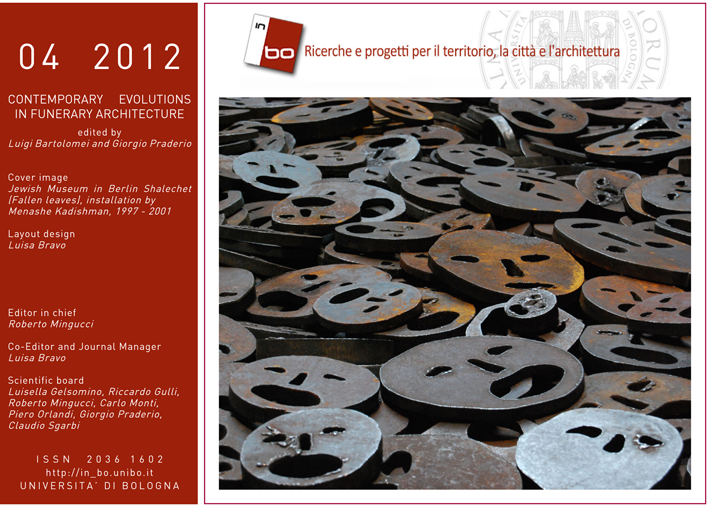Death between 18th Century Discussions and the Cult of Memory. The case of Aristocracy by the Imperial Court of Vienna: The Schwarzenbergs (1780-1900)
DOI:
https://doi.org/10.6092/issn.2036-1602/3258Keywords:
death rituals, history of death and dying, the Schwarzenberg family, 18th century, 19th centuryAbstract
This paper is divided into three parts. The first one deals with death and dying in perspective of contemporary historiography, with particular regards to the italian one. Death is an essential topic for European historians, because it is understood to be an experimental research subject. The specific field of interests, in fact, is not the death itself, but the living strategies of people of various historical periods and social classes.
Another part of this article focuses on some important changes in the relationship between the quick and the dead which appeared during the 18th century. Death became a crucial issue of the 18th century medicine and since that time dying has stopped to be a strictly religious act any more. Another result of 18th century discussions has been that a new cultural phenomenon born: the cemetery. Some new commemorative strategies appeared focusing on a laical family and national memory.
The last part of this essay deals with dying and death rituals in Schwarzenberg family, who played a significant political role at the imperial court of Vienna in the early modern age. Schwarzenbergs relationship with death and dying was quite traditional, paradigmatic, and deeply influenced by the imperial family. Even during the 19th century Schwarzenbergs perceived death rituals and family chapel-tombs as a mean of self-representation and celebration of its special historical position and ancientry.
References
Ariès, Philippe (1977), L’homme devant la mort, Èditions du Seuil, Paris
Barbarisi, Gennaro. Spaggiari, William (a cura di) (2006), Dei sepolcri di Ugo Foscolo, Cisalpino, Milano
Beckmann, Regine (1997), Der Ahnenkult des Habsburgischen Hochadels am Beispiel aristokratischer Grablegen in Böhmen and Mähren, in: Mžyková, Marie (a cura di), Kamenná kniha / The Stone Book. Sborník k romantickému historismu – novogotice, Zámek Sychrov, Sychrov
Buccini, Stefania (2000), Sentimento della morte dal Barocco al declino dei Lumi, Longo Editore, Ravenna
Cosmacini, Giorgio (2007), La religiosità della medicina. Dall’antichità a oggi, Editori Laterza, Roma-Bari
Cosmacini, Giorgio – Vigarello, Georges (a cura di) (2008), Il medico di fronte alla morte (secoli XVI – XXI), Fondazione Ariodante Fabretti, Torino
Cosmacini, Giorgio (2006), Le spade di Damocle. Paure e malattie nella storia, Editori Laterza, Roma-Bari
Danelon, Fabio (a cura di) (2008), “A egregie coseˮ. Studi sui “Sepolcriˮ di Ugo Foscolo, Marsilio, Venezia
Di Lampedusa, Tomasi Giuseppe (2003), Il Gattopardo, Feltrinelli, Milano.
Frank, Pietro Giovanni (1818), Sistema compiuto della polizia medica XI, Milano
Gaži, Martin (a cura di) (2008), Schwarzenbergové v české a středoevropské kulturní historii, Národní památkový ústav, České Budějovice
Grmek, Mirko D. (a cura di) (1998), Storia del pensiero medico occidentale. 3. Dall’età romantica alla medicina moderna, Editori Laterza, Roma-Bari
Grubhoffer, Václav (2010), Dying, Death and Funeral Ceremonies of Austrian Aristocracy in the 19th Century Habsburg Monarchy (an Example of the Schwarzenberg Family), in Annales Universitatis Apulensis. Series Historica, Universitatea „1 Decembrie 1918“ Alba Iulia, Special Issue.
Halbwachs, Maurice (1968), La mèmoire collective, Presses Universitaires de France, Paris
Hengerer, Mark (2005), Adelsgräber im Wien des 18. Jahrhunderts. Beobachtungen zu einer Archäologie des adeligen Gedächtnisses, in Hengerer, Mark (a cura di), Macht und Memoria. Begräbniskultur europäischer Oberschichten in der Frühen Neuzeit, Böhlau Verlag, Köln-Weimar-Wien
Landriani, Marsilio (1775), Ricerche fisiche intorno alla salubrità dell’aria, Milano
Manni, Pietro (1835), Manuale pratico per la cura degli apparentemente morti. Alcune idee generali di polizia medica per la tutela della vita negli asfittici, Milano
Milanesi, Claudio (1989), Morte apparente e morte intermedia. Medicina e mantalità nel dibattito sullʼincertezza dei segni della morte (1740 – 1789), Istituto della Enciclopedia Italiana, Roma
Pellegrini, Ernestina (1996), Necropoli immaginarie. Le rappresentazioni della morte in Balzac, Flaubert, Zola, Dickens, Dostojevskij e Tolstoj, Le Lettere, Firenze
Petrucci, Armando (1995), Le scritture ultime: ideologia della morte e strategie dello scrivere nella tradizione occidentale, Einaudi, Torino
Popelka, Liselotte (1994), Castrum Doloris oder "Trauriger Schauplatz": Untersuchungen zu Entstehung und Wesen ephemer[er] Architektur, Verlag der österreichischen Akademie der Wissenschaften, Wien
Rau, Thomas Wolfgang (1764), Medicinische Policey-Ordnung. Gedanken von den Nutzen und die Nothwendigkeit einer medicinischer Policey-Ordnung in einem Staat, Ulm
Rohan, Inge (2002), Die Gruftkirche der Fürsten Schwarzenberg in Třeboň (Wittingau). Familiengrablege und neogotisches Denkmal des Glaubens, in: Institut für Kunstgeschichte der Universität Salzburg (a cura di), Das Wesen Österreichs ist nicht Zentrum, sondern Peripherie. Gedenkschrift für Hugo Rokyta (1912-1999), Vitalis, Praha-Furth im Wald
Sozzi, Marina (2009), Reinventare la morte. Introduzione alla tanatologia, Editori Laterza, Roma-Bari
Sozzi, Marina. Porset, Charles (1999), Il sonno e la memoria. Idee della morte e politiche funerarie nella Rivoluzione francese, Paravia, Torino
Tenenti, Alberto (1957), Il senso della morte e l'amore della vita nel Rinascimento (Francia e Italia), Giulio Einaudi editore, Torino
Tomasi, Grazia (2001), Per salvare i viventi. Le origini settecentesche del cimitero extraurbano, Il Mulino, Bologna
Van de Water-Hawlik, Magdalena (1989), Der schöne Tod. Zeremonialstrukturen des Wiener Hofes bei Tod und Begräbnis zwischen 1640 und 1740, Herder, Wien-Freiburg-Basel
Vovelle, Michel (1983), La Mort et l’Occident de 1300 à nos jours, Gallimard, Paris
Wimmer, Johannes (1991), Gesundheit, Krankheit und Tod im Zeitalter der Aufklärung. Fallstudien aus den habsburgischen Erbländern, Böhlau, Wien-Köln
Downloads
Published
How to Cite
Issue
Section
License
Copyright (c) 2012 Václav Grubhoffer
Copyrights and publishing rights of all the texts on this journal belong to the respective authors without restrictions.
This journal is licensed under a Creative Commons Attribution-NonCommercial 4.0 International License (full legal code).
See also our Open Access Policy.
Metadata
All the metadata of the published material is released in the public domain and may be used by anyone free of charge. This includes references.
Metadata — including references — may be re-used in any medium without prior permission for both not-for-profit and for-profit purposes. We kindly ask users to provide a link to the original metadata record.







